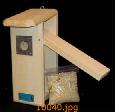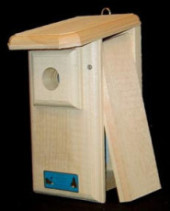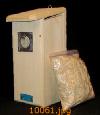
   |
 |
|
|
|
Close to twenty species of woodpeckers live in North America. Most woodpeckers live all year in the same area and don't migrate. Woodpeckers can be found in a variety of habitats including farmlands, open woodlands, orchards, oak and pine woods, parks and gardens. Woodpeckers are very beneficial to our environment. They eat thousands of wood boring insects and other garden pests. You can usually observe most woodpeckers spiraling around a tree trunk in search of food. Attracting woodpeckers to your own backyard is very enjoyable and these perky birds will reward you by eating insect pests in your garden such as crickets, ants, grasshoppers, flies, spiders, wasps, beetles, and grubs. A single flicker can eat thousands of carpenter ants in one day! ATTRACTING WOODPECKERS TO YOUR BACKYARDHere's some great tips on how to get these perky birds to visit your backyard:
|
 Coveside Conservation Windowsill Feeder Natural
Coveside Conservation Windowsill Feeder Natural
Coveside Conservation windowsill feeders will give you plenty of up close bird viewing from the comfort of your home. The feeders are designed to sit on your windowsill and are held in place by easy to use spring set dowels that fit securely in the screen window tracks. •Open Back and acrylic top gives you plenty of great viewing • Fits double hung windows up to 38" wide • Perforated metal screen feeding platform for proper drainage. • Clean and fill from the inside of your house |
 Coveside Downy Woodpecker House
Coveside Downy Woodpecker House
America's smallest woodpecker, the Downy is a
backyard favorite. They are friendly little birds that
enjoy being around people. Since Downys tend to use nest boxes in the winter as
roosts to escape the cold, one might want to put up a house in the fall. Comes
standard with slate squirrel guard and wood chips. |
 Coveside Mountain Bluebird House
Coveside Mountain Bluebird House
The largest of the bluebird houses, this box provides an ideal cavity for the only "all-blue" bluebird. RANGE: Breeds from southern Alaska, Mackenzie and Manitoba south to western Nebraska, New Mexico, Arizona and west to the coast. Winters from British Columbia and Montana south through western U.S. HABITAT: Breeds in high mountain meadows with scattered trees and bushes; in winter descends to lower elevations, where it prefers the plains and grasslands. (12-1/2"h x 7-1/4"w x 9"d) |
 Coveside Northern Flicker House
Coveside Northern Flicker House
The Northern Flicker is a woodpecker that utilizes a bird house quite readily. If there is a problem with a flicker pecking a hole in a building, fill the this house with wood chips and position it over the unwanted excavation to provide a more suitable nesting location. RANGE: Resides throughout the U.S. and Canada. HABITAT: Prefers open country with trees, parks and large gardens; especially in or at the edge of open woods.. (17-3/4"h x 9-1/4"w x 11"d) |
 Coveside Three Woodpecker House
Coveside Three Woodpecker House
Only a few varieties of woodpeckers will live in a man-made box, but the Hairy, Red-headed and Red-bellied Woodpeckers regularly do so. This house comes with wood chips and a slate predator guard to keep squirrels from enlarging the entrance hole. RANGE: Resides throughout the U.S. and Canada, and north to Alaska. Some northern birds move south for the winter. HABITAT: Lives in or at the edge of open woods, prefering deciduous forests. (17-1/2"h x 7-1/2"w x 9-3/4"d) |
|
Ads If you are looking for running a bed and breakfast then click here . |

Home
Page |
Product Review Page | Help
 Woodside Gardens
The Registry of Nature Habitats
Woodside Gardens
The Registry of Nature Habitats 
 1999 -
1999 -
All Rights Reserved
Last Updated: